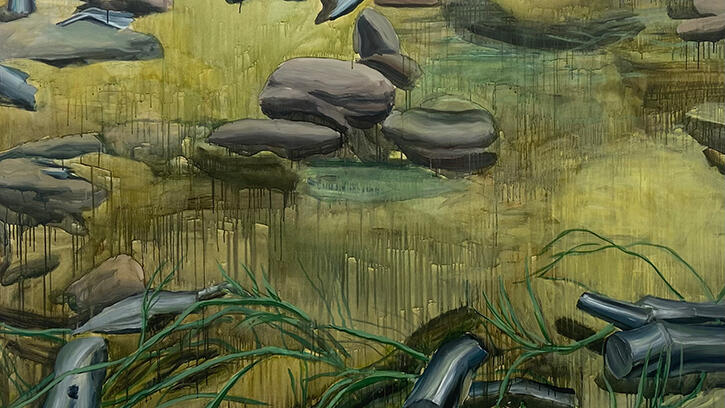A Painter Keeps the Memory of Luhansk Alive
After fleeing the city in 2014, Kateryna Aliinyk remembers the landscape of her childhood
After fleeing the city in 2014, Kateryna Aliinyk remembers the landscape of her childhood

Since I left Luhansk as a teenager after the 2014 Russian invasion, I haven’t dared to work in any other garden except the one from my childhood. I used to spend hours tending this special place and after I left, I’ve decided to preserve those memories until I can physically return to my home. We seldom witness the full scale of mutations and transformations happening in cities that have been invaded by Russia. I can only speculate about life on the eastern side of the ‘border’, where much of my family still lives. Their decision to stay had nothing to do with politics: they were attached to the land and soil.
In my own practice as a painter, I began to think about those private patches of land in occupied territories, in which the less obvious processes of war slowly grind on. Artillery warfare, landmines and blood change the landscape significantly over time. Painting grenades buried underground was my first step towards facing the violent collision of tragedy with the most peaceful aspects of life. Watching my family’s small gestures of resistance, like maintaining the garden for my return after Ukraine’s victory, I have hope; a grenade is bound to rot.

Once a familiar sight, the forests, rivers and fields of eastern Ukraine are now inaccessible; I can only observe them from a distance. The green fields of feather grass – the symbol of the Luhansk region – the chalk mountains and the slag heaps have been consigned to my private imaginary. Now, the beauty of these places – which I always hoped to visit on one of the few return trips I have made since the occupation – is interlaced with the threat of explosions. I have a desperate desire to approach this landscape through my work. Most of my paintings attempt to place the viewer in positions and situations where they do not belong. I paint distorted subterranean images because, even if a landscape does not seem to retain traces of tragedy for long, in the end, a closer look usually reveals its presence.
At first glance, landscapes where no one ventures anymore can appear to undergo a ‘revival’ because people have stopped visiting. Beneath this flourishing greenery, however, we keep finding evidence of war crimes. Even in agricultural spaces, land mines, wreckage from rockets and human remains now forcibly coexist alongside edible plants. Especially this year, few tended the beauty of the gardens. Mostly, we worried whether the harvest was edible. Or had we just lost our appetites?

The full-scale Russian invasion has turned most of eastern Ukraine into ruins and brought immeasurable suffering to all those living there. While Ukrainians are liberating territories and trying to preserve everything possible, non-human agents are also dealing with partially poisoned lands, digesting and diluting the liquids of war that have seeped into the soil. A nonanthropocentric view in my works is crucial because it reminds me about layers of yet undiscovered damage we will face and recover.
This article first appeared in frieze issue 232 as part of a dossier with the headline ‘Forms of Resistance’
Main image: Kateryna Aliinyk, Neglected part of the garden, 2022. Courtesy: the artist























